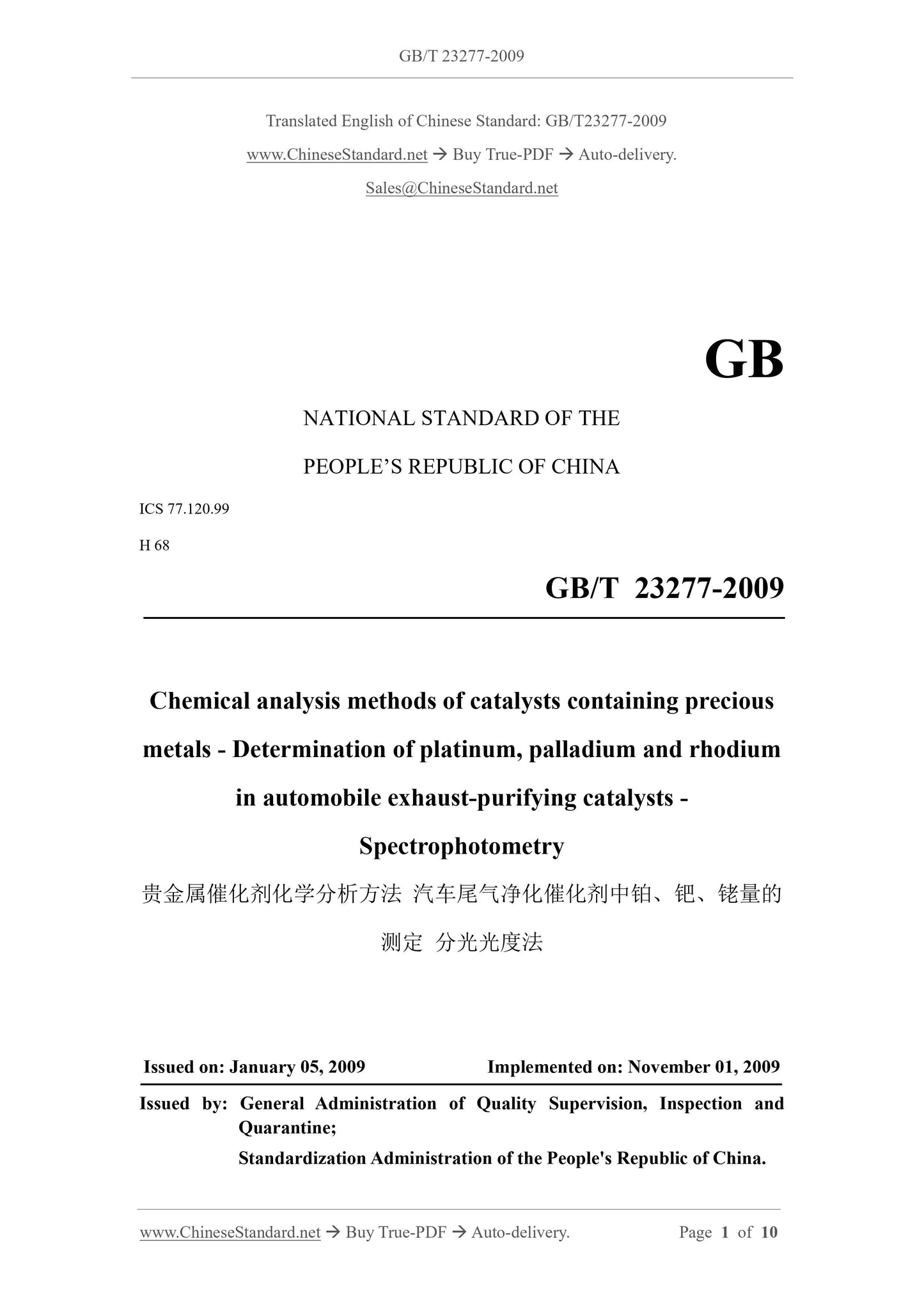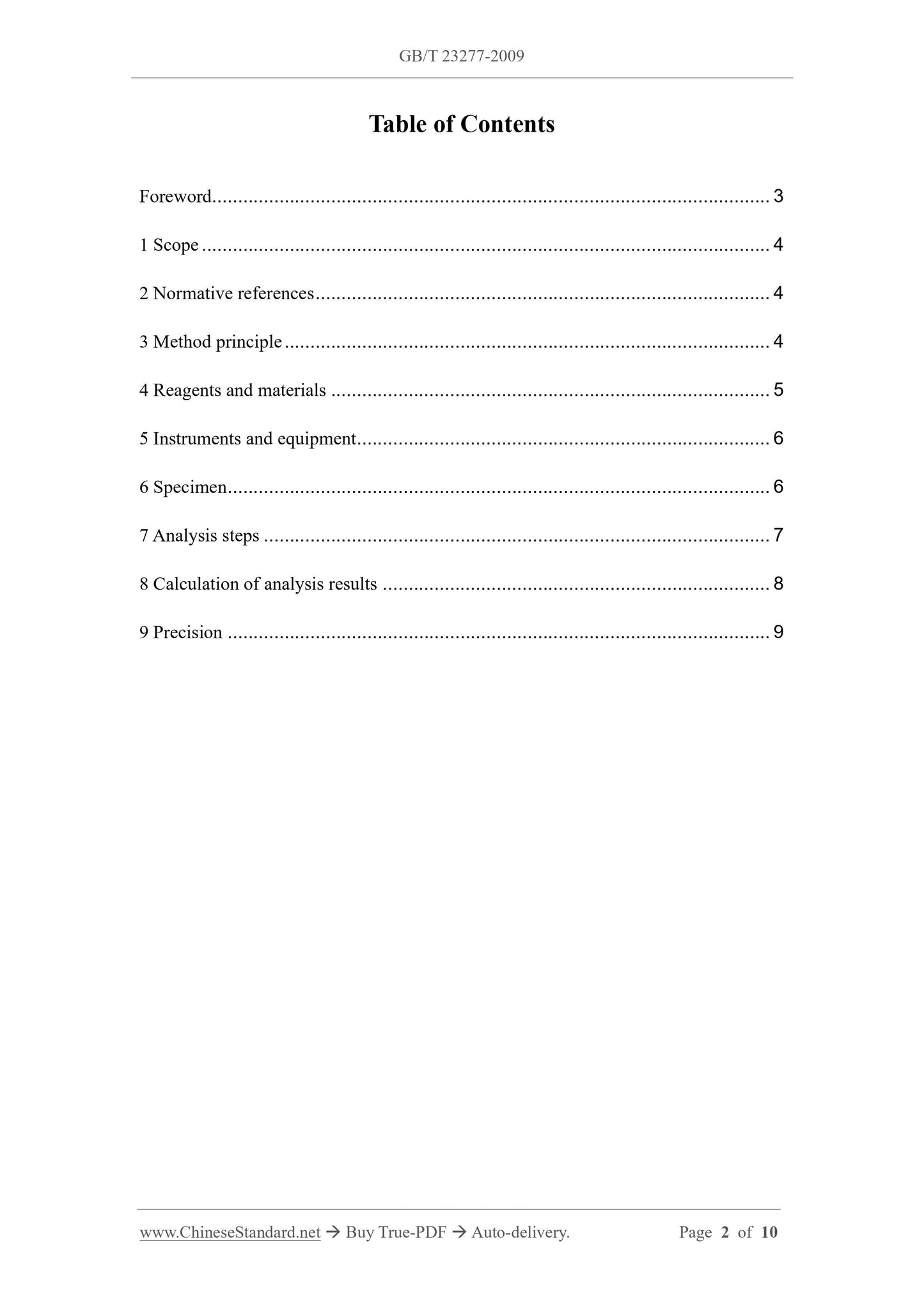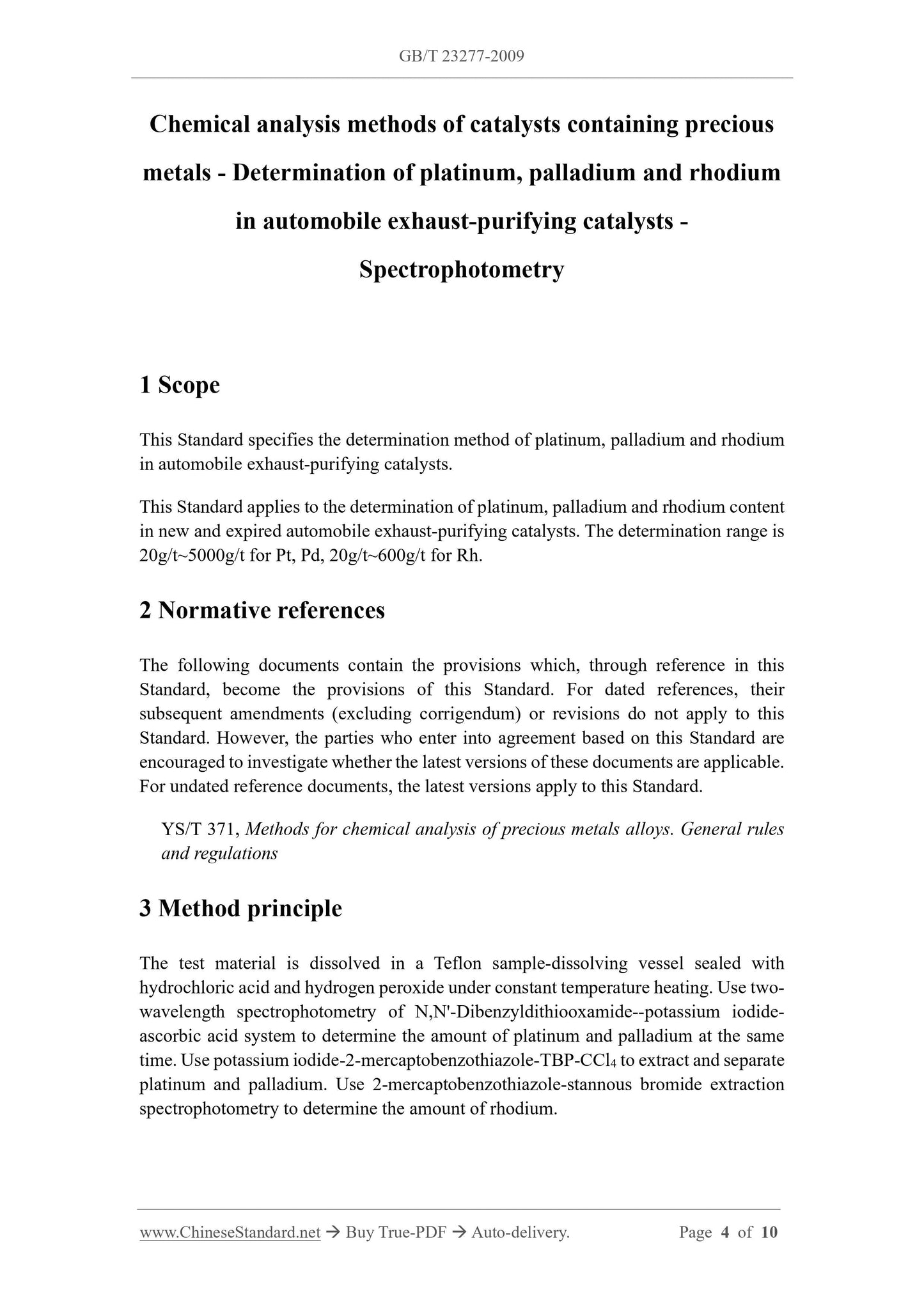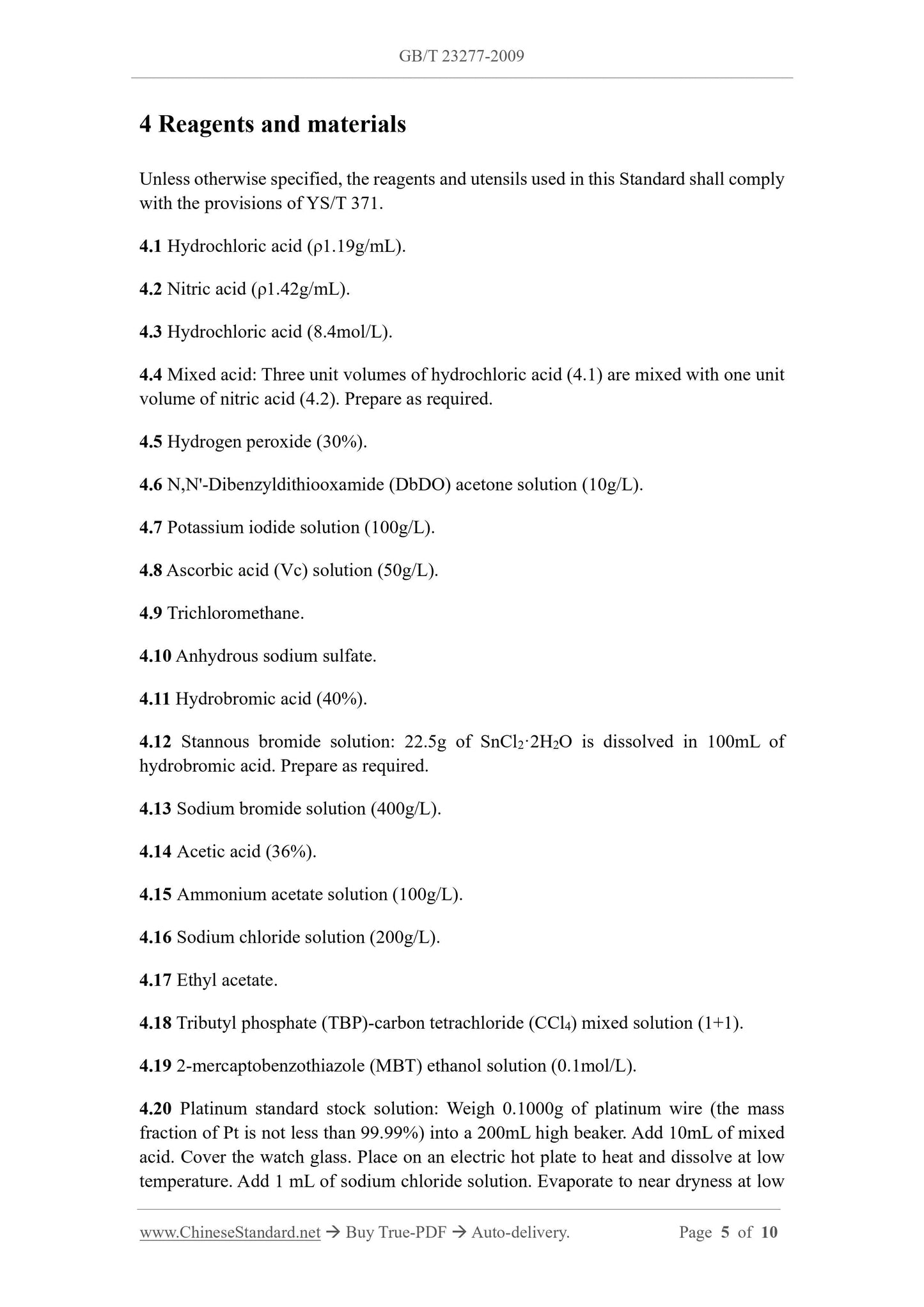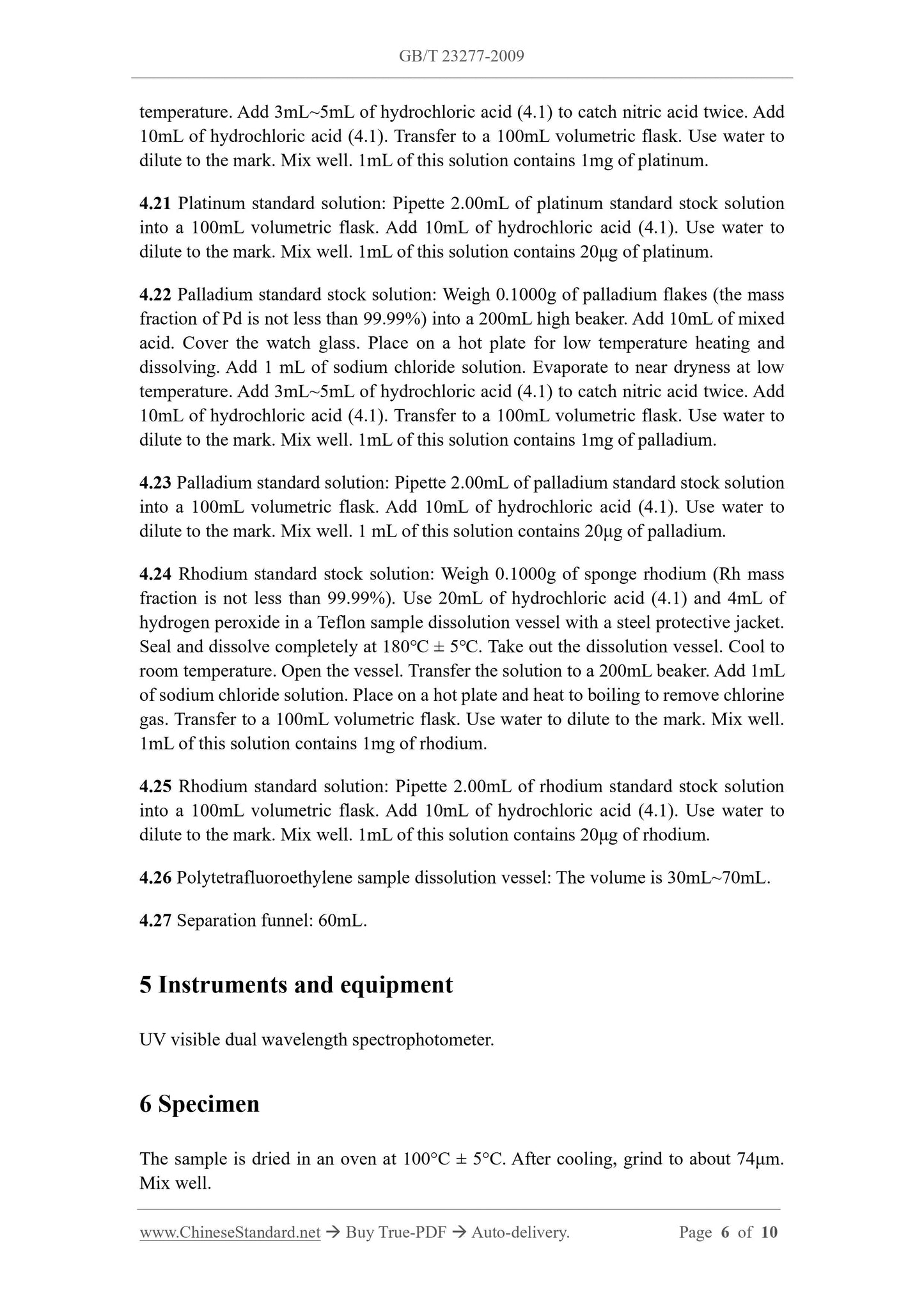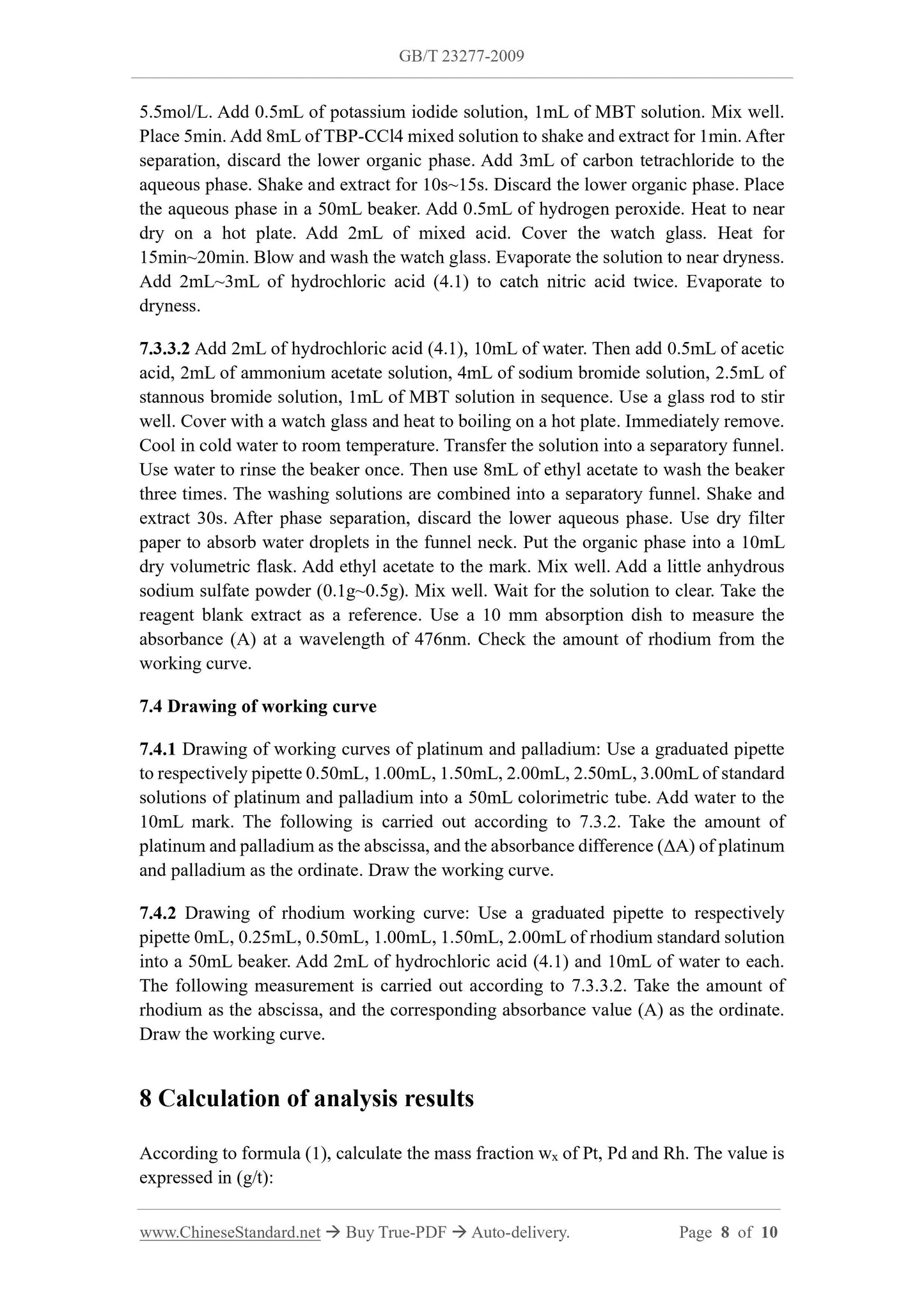1
/
of
6
PayPal, credit cards. Download editable-PDF & invoice In 1 second!
GB/T 23277-2009 English PDF (GBT23277-2009)
GB/T 23277-2009 English PDF (GBT23277-2009)
Regular price
$110.00 USD
Regular price
Sale price
$110.00 USD
Unit price
/
per
Shipping calculated at checkout.
Couldn't load pickup availability
Delivery: 3 seconds. Download true-PDF + Invoice.
Get QUOTATION in 1-minute: Click GB/T 23277-2009
Historical versions: GB/T 23277-2009
Preview True-PDF (Reload/Scroll if blank)
GB/T 23277-2009: Chemical analysis methods of catalysts containing precious metals -- Determination of platinum, palladium and rhodium in automobile exhaust-purifying catalysts -- Spectrophotometry
GB/T 23277-2009
NATIONAL STANDARD OF THE
PEOPLE’S REPUBLIC OF CHINA
ICS 77.120.99
H 68
Chemical analysis methods of catalysts containing precious
metals - Determination of platinum, palladium and rhodium
in automobile exhaust-purifying catalysts -
Spectrophotometry
ISSUED ON: JANUARY 05, 2009
IMPLEMENTED ON: NOVEMBER 01, 2009
Issued by: General Administration of Quality Supervision, Inspection and
Quarantine;
Standardization Administration of the People's Republic of China.
Table of Contents
Foreword ... 3
1 Scope ... 4
2 Normative references ... 4
3 Method principle ... 4
4 Reagents and materials ... 5
5 Instruments and equipment ... 6
6 Specimen ... 6
7 Analysis steps ... 7
8 Calculation of analysis results ... 8
9 Precision ... 9
Chemical analysis methods of catalysts containing precious
metals - Determination of platinum, palladium and rhodium
in automobile exhaust-purifying catalysts -
Spectrophotometry
1 Scope
This Standard specifies the determination method of platinum, palladium and rhodium
in automobile exhaust-purifying catalysts.
This Standard applies to the determination of platinum, palladium and rhodium content
in new and expired automobile exhaust-purifying catalysts. The determination range is
20g/t~5000g/t for Pt, Pd, 20g/t~600g/t for Rh.
2 Normative references
The following documents contain the provisions which, through reference in this
Standard, become the provisions of this Standard. For dated references, their
subsequent amendments (excluding corrigendum) or revisions do not apply to this
Standard. However, the parties who enter into agreement based on this Standard are
encouraged to investigate whether the latest versions of these documents are applicable.
For undated reference documents, the latest versions apply to this Standard.
YS/T 371, Methods for chemical analysis of precious metals alloys. General rules
and regulations
3 Method principle
The test material is dissolved in a Teflon sample-dissolving vessel sealed with
hydrochloric acid and hydrogen peroxide under constant temperature heating. Use two-
wavelength spectrophotometry of N,N'-Dibenzyldithiooxamide--potassium iodide-
ascorbic acid system to determine the amount of platinum and palladium at the same
time. Use potassium iodide-2-mercaptobenzothiazole-TBP-CCl4 to extract and separate
platinum and palladium. Use 2-mercaptobenzothiazole-stannous bromide extraction
spectrophotometry to determine the amount of rhodium.
4 Reagents and materials
Unless otherwise specified, the reagents and utensils used in this Standard shall comply
with the provisions of YS/T 371.
4.1 Hydrochloric acid (ρ1.19g/mL).
4.2 Nitric acid (ρ1.42g/mL).
4.3 Hydrochloric acid (8.4mol/L).
4.4 Mixed acid: Three unit volumes of hydrochloric acid (4.1) are mixed with one unit
volume of nitric acid (4.2). Prepare as required.
4.5 Hydrogen peroxide (30%).
4.6 N,N'-Dibenzyldithiooxamide (DbDO) acetone solution (10g/L).
4.7 Potassium iodide solution (100g/L).
4.8 Ascorbic acid (Vc) solution (50g/L).
4.9 Trichloromethane.
4.10 Anhydrous sodium sulfate.
4.11 Hydrobromic acid (40%).
4.12 Stannous bromide solution: 22.5g of SnCl2·2H2O is dissolved in 100mL of
hydrobromic acid. Prepare as required.
4.13 Sodium bromide solution (400g/L).
4.14 Acetic acid (36%).
4.15 Ammonium acetate solution (100g/L).
4.16 Sodium chloride solution (200g/L).
4.17 Ethyl acetate.
4.18 Tributyl phosphate (TBP)-carbon tetrachloride (CCl4) mixed solution (1+1).
4.19 2-mercaptobenzothiazole (MBT) ethanol solution (0.1mol/L).
4.20 Platinum standard stock solution: Weigh 0.1000g of platinum wire (the mass
fraction of Pt is not less than 99.99%) into a 200mL high beaker. Add 10mL of mixed
acid. Cover the watch glass. Place on an electric hot plate to heat and dissolve at low
temperature. Add 1 mL of sodium chloride solution. Evaporate to near dryness at low
temperature. Add 3mL~5mL of hydrochloric acid (4.1) to catch nitric acid twice. Add
10mL of hydrochloric acid (4.1). Transfer to a 100mL volumetric flask. Use water to
dilute to the mark. Mix well. 1mL of this solution contains 1mg of platinum.
4.21 Platinum standard solution: Pipette 2.00mL of platinum standard stock solution
into a 100mL volumetric flask. Add 10mL of hydrochloric acid (4.1). Use water to
dilute to the mark. Mix well. 1mL of this solution contains 20μg of platinum.
4.22 Palladium standard stock solution: Weigh 0.1000g of palladium flakes (the mass
fraction of Pd is not less than 99.99%) into a 200mL high beaker. Add 10mL of mixed
acid. Cover the watch glass. Place on a hot plate for low temperature heating and
dissolving. Add 1 mL of sodium chloride solution. Evaporate to near dryness at low
temperature. Add 3mL~5mL of hydrochloric acid (4.1) to catch nitric acid twice. Add
10mL of hydrochloric acid (4.1). Transfer to a 100mL volumetric flask. Use water to
dilute to the mark. Mix well. 1mL of this solution contains 1mg of palladium.
4.23 Palladium standard solution: Pipette 2.00mL of palladium standard stock solution
into a 100mL volumetric flask. Add 10mL of hydrochloric acid (4.1). Use water to
dilute to the mark. Mix well. 1 mL of this solution contains 20μg of palladium.
4.24 Rhodium standard stock solution: Weigh 0.1000g of sponge rhodium (Rh mass
fraction is not less than 99.99%). Use 20mL of hydrochloric acid (4.1) and 4mL of
hydrogen peroxide in a Teflon sample dissolution vessel with a steel protective jacket.
Seal and dissolve completely at 180℃ ± 5℃. Take out the dissolution vessel. Cool to
room temperature. Open the vessel. Transfer the solution to a 200mL beaker. Add 1mL
of sodium chloride solution. Place on a hot plate and heat to boiling to remove chlorine
gas. Transfer to a 100mL volumetric flask. Use water to dilute to the mark. Mix well.
1mL of this solution contains 1mg of rhodium.
4.25 Rhodium standard solution: Pipette 2.00mL of rhodium standard stock solution
into a 100mL volumetric flask. Add 10mL of hydrochloric acid (4.1). Use water to
dilute to the mark. Mix well. 1mL of this solution contains 20μg of rhodium.
4.26 Polytetrafluoroethylene sample dissolution vessel: The volume is 30mL~70mL.
4.27 Separation funnel: 60mL.
5 Instruments and equipment
UV visible dual wavelength spectrophotometer.
6 Specimen
The sample is dried in an oven at 100°C ± 5°C. After cooling, grind to about 74μm.
Mix well.
5.5mol/L. Add 0.5mL of potassium iodide solution, 1mL of MBT solution. Mix well.
Place 5min. Add 8mL of TBP-CCl4 mixed solution to shake and extract for 1min. After
separation, discard the lower organic phase. Add 3mL of carbon tetrachloride to the
aqueous phase. Shake and extract for 10s~15s. Discard the lower organic phase. Place
the aqueous phase in a 50mL beaker. Add 0.5mL of hydrogen peroxide. Heat to near
dry on a hot plate. Add 2mL of mixed acid. Cover the watch glass. Heat for
15min~20min. Blow and wash the watch glass. Evaporate the solution to near dryness.
Add 2mL~3mL of hydrochloric acid (4.1) to catch nitric acid twice. Evaporate to
dryness.
7.3.3.2 Add 2mL of hydrochloric acid (4.1), 10mL of water. Then add 0.5mL of acetic
acid, 2mL of ammonium acetate solution, 4mL of sodium bromide solution, 2.5mL of
stannous bromide solution, 1mL of MBT solution in sequence. Use a glass rod to stir
well. Cover with a watch glass and heat to boiling on a hot plate. Immediately remove.
Cool in cold water to room tempe...
Get QUOTATION in 1-minute: Click GB/T 23277-2009
Historical versions: GB/T 23277-2009
Preview True-PDF (Reload/Scroll if blank)
GB/T 23277-2009: Chemical analysis methods of catalysts containing precious metals -- Determination of platinum, palladium and rhodium in automobile exhaust-purifying catalysts -- Spectrophotometry
GB/T 23277-2009
NATIONAL STANDARD OF THE
PEOPLE’S REPUBLIC OF CHINA
ICS 77.120.99
H 68
Chemical analysis methods of catalysts containing precious
metals - Determination of platinum, palladium and rhodium
in automobile exhaust-purifying catalysts -
Spectrophotometry
ISSUED ON: JANUARY 05, 2009
IMPLEMENTED ON: NOVEMBER 01, 2009
Issued by: General Administration of Quality Supervision, Inspection and
Quarantine;
Standardization Administration of the People's Republic of China.
Table of Contents
Foreword ... 3
1 Scope ... 4
2 Normative references ... 4
3 Method principle ... 4
4 Reagents and materials ... 5
5 Instruments and equipment ... 6
6 Specimen ... 6
7 Analysis steps ... 7
8 Calculation of analysis results ... 8
9 Precision ... 9
Chemical analysis methods of catalysts containing precious
metals - Determination of platinum, palladium and rhodium
in automobile exhaust-purifying catalysts -
Spectrophotometry
1 Scope
This Standard specifies the determination method of platinum, palladium and rhodium
in automobile exhaust-purifying catalysts.
This Standard applies to the determination of platinum, palladium and rhodium content
in new and expired automobile exhaust-purifying catalysts. The determination range is
20g/t~5000g/t for Pt, Pd, 20g/t~600g/t for Rh.
2 Normative references
The following documents contain the provisions which, through reference in this
Standard, become the provisions of this Standard. For dated references, their
subsequent amendments (excluding corrigendum) or revisions do not apply to this
Standard. However, the parties who enter into agreement based on this Standard are
encouraged to investigate whether the latest versions of these documents are applicable.
For undated reference documents, the latest versions apply to this Standard.
YS/T 371, Methods for chemical analysis of precious metals alloys. General rules
and regulations
3 Method principle
The test material is dissolved in a Teflon sample-dissolving vessel sealed with
hydrochloric acid and hydrogen peroxide under constant temperature heating. Use two-
wavelength spectrophotometry of N,N'-Dibenzyldithiooxamide--potassium iodide-
ascorbic acid system to determine the amount of platinum and palladium at the same
time. Use potassium iodide-2-mercaptobenzothiazole-TBP-CCl4 to extract and separate
platinum and palladium. Use 2-mercaptobenzothiazole-stannous bromide extraction
spectrophotometry to determine the amount of rhodium.
4 Reagents and materials
Unless otherwise specified, the reagents and utensils used in this Standard shall comply
with the provisions of YS/T 371.
4.1 Hydrochloric acid (ρ1.19g/mL).
4.2 Nitric acid (ρ1.42g/mL).
4.3 Hydrochloric acid (8.4mol/L).
4.4 Mixed acid: Three unit volumes of hydrochloric acid (4.1) are mixed with one unit
volume of nitric acid (4.2). Prepare as required.
4.5 Hydrogen peroxide (30%).
4.6 N,N'-Dibenzyldithiooxamide (DbDO) acetone solution (10g/L).
4.7 Potassium iodide solution (100g/L).
4.8 Ascorbic acid (Vc) solution (50g/L).
4.9 Trichloromethane.
4.10 Anhydrous sodium sulfate.
4.11 Hydrobromic acid (40%).
4.12 Stannous bromide solution: 22.5g of SnCl2·2H2O is dissolved in 100mL of
hydrobromic acid. Prepare as required.
4.13 Sodium bromide solution (400g/L).
4.14 Acetic acid (36%).
4.15 Ammonium acetate solution (100g/L).
4.16 Sodium chloride solution (200g/L).
4.17 Ethyl acetate.
4.18 Tributyl phosphate (TBP)-carbon tetrachloride (CCl4) mixed solution (1+1).
4.19 2-mercaptobenzothiazole (MBT) ethanol solution (0.1mol/L).
4.20 Platinum standard stock solution: Weigh 0.1000g of platinum wire (the mass
fraction of Pt is not less than 99.99%) into a 200mL high beaker. Add 10mL of mixed
acid. Cover the watch glass. Place on an electric hot plate to heat and dissolve at low
temperature. Add 1 mL of sodium chloride solution. Evaporate to near dryness at low
temperature. Add 3mL~5mL of hydrochloric acid (4.1) to catch nitric acid twice. Add
10mL of hydrochloric acid (4.1). Transfer to a 100mL volumetric flask. Use water to
dilute to the mark. Mix well. 1mL of this solution contains 1mg of platinum.
4.21 Platinum standard solution: Pipette 2.00mL of platinum standard stock solution
into a 100mL volumetric flask. Add 10mL of hydrochloric acid (4.1). Use water to
dilute to the mark. Mix well. 1mL of this solution contains 20μg of platinum.
4.22 Palladium standard stock solution: Weigh 0.1000g of palladium flakes (the mass
fraction of Pd is not less than 99.99%) into a 200mL high beaker. Add 10mL of mixed
acid. Cover the watch glass. Place on a hot plate for low temperature heating and
dissolving. Add 1 mL of sodium chloride solution. Evaporate to near dryness at low
temperature. Add 3mL~5mL of hydrochloric acid (4.1) to catch nitric acid twice. Add
10mL of hydrochloric acid (4.1). Transfer to a 100mL volumetric flask. Use water to
dilute to the mark. Mix well. 1mL of this solution contains 1mg of palladium.
4.23 Palladium standard solution: Pipette 2.00mL of palladium standard stock solution
into a 100mL volumetric flask. Add 10mL of hydrochloric acid (4.1). Use water to
dilute to the mark. Mix well. 1 mL of this solution contains 20μg of palladium.
4.24 Rhodium standard stock solution: Weigh 0.1000g of sponge rhodium (Rh mass
fraction is not less than 99.99%). Use 20mL of hydrochloric acid (4.1) and 4mL of
hydrogen peroxide in a Teflon sample dissolution vessel with a steel protective jacket.
Seal and dissolve completely at 180℃ ± 5℃. Take out the dissolution vessel. Cool to
room temperature. Open the vessel. Transfer the solution to a 200mL beaker. Add 1mL
of sodium chloride solution. Place on a hot plate and heat to boiling to remove chlorine
gas. Transfer to a 100mL volumetric flask. Use water to dilute to the mark. Mix well.
1mL of this solution contains 1mg of rhodium.
4.25 Rhodium standard solution: Pipette 2.00mL of rhodium standard stock solution
into a 100mL volumetric flask. Add 10mL of hydrochloric acid (4.1). Use water to
dilute to the mark. Mix well. 1mL of this solution contains 20μg of rhodium.
4.26 Polytetrafluoroethylene sample dissolution vessel: The volume is 30mL~70mL.
4.27 Separation funnel: 60mL.
5 Instruments and equipment
UV visible dual wavelength spectrophotometer.
6 Specimen
The sample is dried in an oven at 100°C ± 5°C. After cooling, grind to about 74μm.
Mix well.
5.5mol/L. Add 0.5mL of potassium iodide solution, 1mL of MBT solution. Mix well.
Place 5min. Add 8mL of TBP-CCl4 mixed solution to shake and extract for 1min. After
separation, discard the lower organic phase. Add 3mL of carbon tetrachloride to the
aqueous phase. Shake and extract for 10s~15s. Discard the lower organic phase. Place
the aqueous phase in a 50mL beaker. Add 0.5mL of hydrogen peroxide. Heat to near
dry on a hot plate. Add 2mL of mixed acid. Cover the watch glass. Heat for
15min~20min. Blow and wash the watch glass. Evaporate the solution to near dryness.
Add 2mL~3mL of hydrochloric acid (4.1) to catch nitric acid twice. Evaporate to
dryness.
7.3.3.2 Add 2mL of hydrochloric acid (4.1), 10mL of water. Then add 0.5mL of acetic
acid, 2mL of ammonium acetate solution, 4mL of sodium bromide solution, 2.5mL of
stannous bromide solution, 1mL of MBT solution in sequence. Use a glass rod to stir
well. Cover with a watch glass and heat to boiling on a hot plate. Immediately remove.
Cool in cold water to room tempe...
Share
